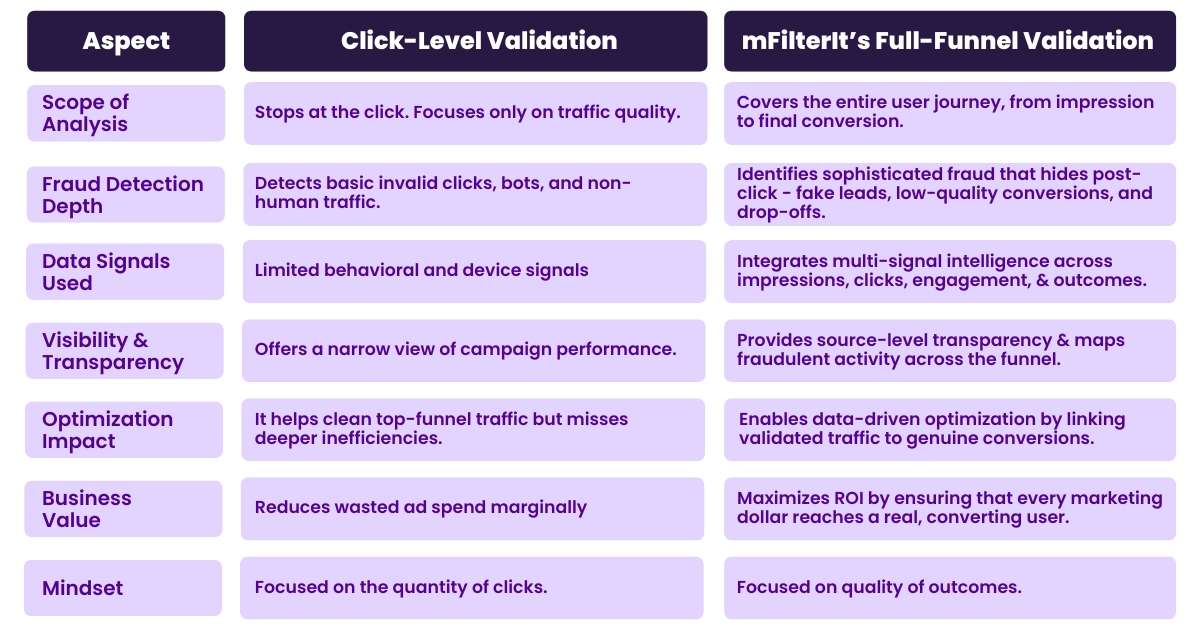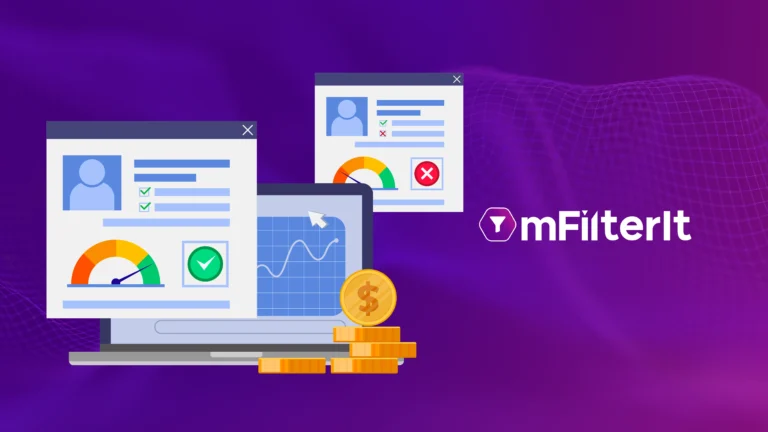For years, marketers have relied on click fraud validation as proof that their campaigns are reaching real users. If the clicks look clean, the traffic must be genuine, right? It’s been the comfort metric, the checkpoint that promises accountability in a noisy digital ecosystem.
But here’s the catch: validating just click fraud doesn’t guarantee real outcomes. Behind a perfectly validated click could be a fake lead, a disengaged visitor, or a bot sophisticated enough to mimic human behavior. You may have solved surface-level traffic hygiene, but not for what truly drives performance — authentic engagement and meaningful conversions.
Because fraudulent activity and inefficiency today don’t stop at activating click fraud. They seep into every stage of the funnel — from impressions to sign-ups, from page visits to purchases. And that’s why click-level validation alone isn’t enough anymore.
In this blog, we’ll explore why clicks can be deceiving, what blind spots they create in your current validation setup, and how a full-funnel validation approach gives marketers the confidence to measure outcome, not just interaction.
What Click Validation Does Right?
Click validation acts as a first line of defense for click fraud prevention. It helps ensure that your campaigns attract genuine clicks from legitimate sources and filter out obvious invalid traffic generated by bots, click farms, and other non-human entities.
By validating ad traffic based on various parameters like device type, IP consistency, geographic locations, and user behavior patterns, click-level validation helps advertisers maintain cleaner campaign data and avoid inflated click-through rates (CTRs).
This allows marketers to:
1. Filter Out Invalid Clicks Early
Click validation detects and blocks fraudulent or non-human clicks in real time, protecting campaigns from the most common forms of click fraud at the entry point.
2. Improve Traffic Quality
By ensuring that only genuine clicks are counted, marketers get higher-quality traffic that’s more likely to engage and convert.
3. Protect Ad Budgets from Immediate Wastage
When fake clicks are filtered out, marketers can prevent their ad spend from getting wasted on irrelevant or non-existent audiences.
4. Get a Clearer View of Engagement
Validating clicks helps refine key engagement metrics like CTR and CPC, giving marketers more accurate insights into ad performance.
5. Enables Smarter Optimization Decisions
With reliable and validated click data, marketers optimize campaigns based on authentic user engagement, not misleading or inflated metrics.
Therefore, click validation helps marketers and advertisers separate real users from fake traffic. However, this is not enough. As user journeys are multi-step and omnichannel, so are the ad fraud techniques used by fraudsters.
Why Click-Level Validation Alone Isn’t Enough Anymore
Modern ad fraud does not stop at click fraud. It runs deeper into the marketing funnel, using sophisticated ad fraud techniques that mimic real user behavior and distort performance metrics across channels.
Here’s how post-click manipulation happens:
1. Misattributed Conversions
Fraudsters hijack genuine user sessions, making fraudulent sources appear to drive conversions that were actually organic or direct.
2. Automated Leads
Form submissions or inquiries that look authentic but are generated through automation or paid farms, offering no real business value.
3. Behavioral Mimicry
Fake engagement patterns simulate actions like scrolling, time-on-page, or app usage, making it difficult for marketers to distinguish real intent from fraudulent activity.
4. Invalid Conversions
Purchases, sign-ups, or installs that seem legitimate but are generated through proxies or emulators instead of genuine customers.
These tactics operate beyond the click, often undetectable to systems that validate only the initial interaction. This leaves a major blind spot in the marketing funnel.
Learn why CPC campaigns need full funnel validation
Beyond Clicks: The Case for Full-Funnel Validation
Click-level validation tools did their job — they brought transparency to the first layer of digital marketing: the traffic. But the problem is, ad fraud didn’t stop there. It evolved.
Today’s fraudsters know how to simulate clicks that look perfectly valid. They can mimic user agents, device IDs, and behavior patterns that fool most detection systems. So, while your dashboard shows “clean” traffic, what happens next — the visit, the sign-up, the purchase — may tell a very different story.
That’s where mFilterIt’s full-funnel validation changes the game.
Instead of stopping at the click, it follows every user journey across the funnel, from impression to final conversion — to ensure that every interaction is genuine, traceable, and outcome-driven. It’s not about rejecting traffic; it’s about validating intent.
Here’s how full-funnel validation redefines campaign integrity
1. Impression-Level Insights
Detect and eliminate fake or stacked impressions before they even lead to a click.
2. Click-Level Validation (and beyond)
Go past the usual hygiene checks to identify behavioral anomalies and proxy patterns even within “clean” clicks.
3. Post-Click Validation
Track what users actually do after clicking — whether they engage, convert, or drop off instantly.
4. Outcome Verification
Validate final conversions to ensure they’re genuine, not fabricated or incentivized actions.
With this end-to-end lens, marketers don’t just see traffic quality — they see business impact.
Full-funnel validation is not just a more advanced version of click validation; it’s a mindset shift from volume to value, from activity to authenticity. Because in the age of performance marketing, real success isn’t measured by clicks; it’s measured by trust.
Read more about how full-funnel validation approach ensures clarity for mobile app campaigns
Click Validation vs. Full-Funnel Validation: A Clear Comparison

Case in Action: How Full-Funnel Validation Drove Real Results for an Automobile Brand
A major automobile brand was running Google Search campaigns to attract new customers and drive website traffic from various Meta platforms. However, despite steady investments in paid search, the brand observed a low and inconsistent conversion ratio.
Upon analysis, it was found that despite blacklisting fraudulent clicks in the upper funnel, the leads quality was still questionable. This meant that the sophisticated bots or advanced ad fraud techniques were used to seep through the validation checks, impacting the bottom funnel. This transparency was identified due to the full-funnel analysis of the campaign, basis on which further measures were taken. Due to active blacklisting at both click and leads stage, the results were:
- 13% reduction in click fraud
- 11% reduction in lead fraud
- 1.75× increase in conversion ratio
- $0.47M in ad spend saved through active blacklisting
Therefore, with full-funnel validation and ad fraud solution in place, the brand achieved end-to-end campaign transparency, cleaner user acquisition, and measurable improvement in performance efficiency.
Conclusion: Go Beyond Click Fraud Detection, Protect Complete Campaign Integrity
Click validation is an important first step; it helps you start clean. But to truly protect your ad spend and performance data, validation has to go deeper. Full-funnel validation gives you that complete picture, making sure every impression, click, and conversion reflects real user intent.
Because when you can trust your data, you can make smarter decisions, optimize confidently, and grow without doubt.
Want to see how mFilterIt’s full-funnel validation approach can strengthen your ad campaigns? Get in touch with our experts now.




